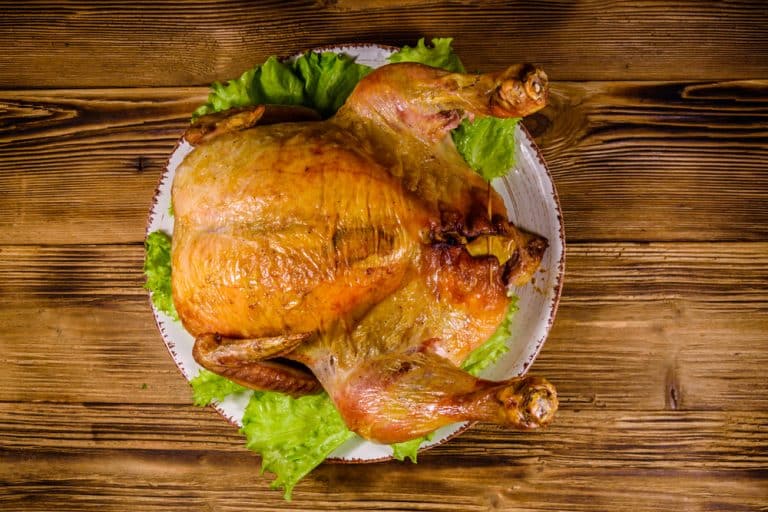The U.S. Department of Agriculture’s Food Safety and Inspection Service (FSIS) is responsible for ensuring the truthfulness and accuracy in labeling meat and poultry products. Knowing the meaning of labels can make purchasing a Thanksgiving turkey a little less confusing.
As the holidays approach, grocery store turkey displays start overflowing with plump birds touting various labels like “young,” “fresh,” and “natural.” But what do these labels actually mean when selecting the star protein for your festive feast? Let’s focus on one of the most common turkey terms – “young turkey” – and decode what this distinction signals about taste, texture and age.
Defining “Young” Turkey
The label “young turkey” indicates that the bird was likely slaughtered between 4 and 8 months of age. At this juvenile stage, the turkey is still considered a “fryer” or “roaster” in poultry farming vocabulary.
Most commercially raised turkeys are slaughtered around 16-18 weeks old, when they reach ideal market weight. So a “young turkey” falls on the younger side of this standard 4-5 month range.
The opposite end of the spectrum is a “yearling” or “mature” turkey which is over 12 months old at slaughter Yearling turkey meat tends to be tougher and less desirable for holiday roasting
Why Opt for a Young Turkey?
Why should you choose a young turkey over a more mature one? Here are some of the key advantages:
-
Tenderness – The meat of younger turkeys is more tender and finely textured since the muscle fibers have had less time to toughen, This makes for easier slicing and a better mouthfeel
-
Juiciness – With less rigid muscle fibers, young turkeys retain more moisture during roasting for juicier meat. Older turkeys can turn out rather dry.
-
Mild flavor – The meat of mature turkeys develops a more pronounced “gamey” taste. Young turkeys offer a milder flavor that most find more appealing for holiday meals.
-
Thin skin – Younger birds have thinner, more delicate skin that crisps up beautifully when roasted The thick skin on older turkeys may toughen and resist crisping
-
Smaller size – Smaller turkeys around 12 lbs or under are more tender and flavorful. A petite turkey is ideal for a smaller gathering.
-
Female gender – Hens (females) generally have finer-grained meat and thinner skin than toms (males). For the best texture, select a small young hen turkey.
Checking Labels for Clarity
Be vigilant about clear labeling when purchasing turkeys. Terms like “premium,” “natural,” and “fresh” don’t have standardized definitions for poultry. But “young” consistently indicates a more tender, younger turkey versus an older “mature” bird.
The U.S. Department of Agriculture (USDA) does verify proper use of terms like “organic,” “free-range,” “no hormones added,” and specific processing claims. Check labels for the USDA seal to ensure truthful labeling.
Roasting Young Turkey for Best Flavor
To make the most of a young turkey’s delicate flavor, avoid heavy seasonings that can overpower it. Simple salt, pepper and herbs allow the natural turkey essence to shine.
Go easy on frequent basting, since opening the oven causes moisture loss. Trust an accurate meat thermometer over recommended roast times for perfect doneness.
Letting the roasted bird rest for at least 20 minutes allows juices to redistribute for maximum juiciness. Carving properly along the grain also preserves moisture.
With the right selection and roasting method, a “young turkey” can deliver sought-after qualities of tenderness, juiciness and pure turkey flavor ideal for impressive holiday meals.
Other Common Turkey Terminology
Here are definitions of some other common labels you may spot in the turkey case:
-
Fresh – Never chilled below 26°F. Should have a “keep refrigerated” statement.
-
Frozen – Temperature of raw turkey is 0°F or below.
-
Hen – A female turkey, smaller than a tom.
-
Tom – A male turkey, larger than a hen.
-
Natural – Contains no artificial ingredients or added color. Minimally processed.
-
No hormones added – It’s illegal to give hormones to poultry in the U.S.
-
No antibiotics – Turkeys must be raised without antibiotics, with documentation.
-
Organic – Meets USDA organic standards like no antibiotics and outdoor access.
The Takeaway
When shopping for the best holiday turkey, prioritize selecting a clearly labeled “young” turkey under 12 pounds for peak tenderness, juiciness and flavor. This indicates a more tender 4-8 month old bird versus a tougher mature yearling. Female hens also have finer texture than males. Check for the USDA seal to verify truthful labeling claims. Then roast your young turkey simply with salt, pepper and herbs to let its natural flavor shine. With the right selection, your holiday feast will be off to a delicious start.
young turkey: 14
fresh: 2
frozen: 1
hen: 2
tom: 2
natural: 1
no hormones added: 1
no antibiotics: 1
organic: 1
USDA: 2

Your Browser is Out-of-date!
It appears youre visiting this site with a browser that is old and unsupported.
To continue using this site and its features, you will need to use a newer browser.
The worlds most used browser.
Internet Explorer for the modern age.
A great alternative browser focused on user privacy.
The U.S. Department of Agriculture’s Food Safety and Inspection Service (FSIS) is responsible for ensuring the truthfulness and accuracy in labeling meat and poultry products. Knowing the meaning of labels can make purchasing a Thanksgiving turkey a little less confusing.
Whole poultry and cuts that have never been below 26 degrees Fahrenheit. Fresh poultry should always bear a “keep refrigerated” statement.
Temperature of raw, frozen poultry is 0 degrees Fahrenheit or below.
The sex designation of “hen” (female) or “tom” (male) turkey is optional on the label. It is an indication of size rather than the tenderness of a turkey.
Poultry contains no artificial ingredients or added color and is minimally processed.
Under federal law, hormones aren’t allowed in raising poultry. Therefore, the claim “no hormones added” can’t be used on poultry labels unless it is followed by a statement that says, “Federal regulations prohibit the use of hormones.”
The terms “no antibiotics added” may be used on labels for poultry if sufficient documentation is provided by the producer to the FSIS demonstrating that the animals were raised without antibiotics. However, all meat and poultry is antibiotic free. Turkeys can’t receive antibiotics prior to harvest. Turkeys are tested at harvest to ensure the poultry is free of residual antibiotics.
The turkey farm must meet the U.S. Department of Agriculture’s certified organic program standards. Organic doesn’t mean the turkey is safer or raised more humanely; rather, it means the turkey is raised without antibiotics and has access to the outdoors.
Young: Turkeys of either sex that are less than 8 months of age.
Want more news on this topic? Farm Bureau members may subscribe for a free email news service, featuring the farm and rural topics that interest them most!
Young turkey cook on Thanksgiving ️ #turkey #thanksgiving #food
FAQ
Is young turkey better than regular turkey?
Turkeys younger than seven months are more tender and flavorful. So, when you see the older turkey that’s cheaper keep in mind that turkey might be tougher. Turkeys older than 15 months old are not recommended.
What does a young turkey mean?
The U.S. Department of Agriculture does not define “young” for turkeys, but it requires that turkeys that lived more than a year be labeled as “yearling” or “mature.” Natural.
What was a young turkey?
A young turkey is called a poult.
What’s the difference between a young turkey and a tom turkey?
Turkeys can also be labeled with terms such as fryer-roaster (a young turkey, usually less than 16 weeks of age); hen (a female turkey); or tom (a male turkey). The terms ‘hen’ and ‘tom’ are an indication of size rather than tenderness, with tom turkeys generally larger than hens.
Why is a young turkey a good choice?
The young turkey is known for the high-quality meat because it’s said that the younger the bird, the better the meat. To illustrate, young turkey has smooth and soft skin which comes out extremely delicious and crispy. Even more, the young turkey has tender meat which cooks into the moist and juicy meat.
Are young turkeys the same as regular turkeys?
Young turkeys are not the same as regular turkeys. They are smaller and younger than regular turkeys. Their meat is leaner and milder in flavor. They are usually sold whole and dressed. Young turkeys weigh about 5 pounds each. Regular turkeys weigh between 12 and 15 pounds each.
What is the difference between a young Turkey and a Butterball turkey?
A young turkey is generally smaller and leaner than a full grown adult turkey. Young turkeys are generally sold whole or half. A Butterball turkey is a mature turkey that is ready to eat. It is usually about 12 pounds and has been fed and raised for several months. Butterballs are available in either whole or half sizes.
Are young turkeys better than older turkeys?
Young turkeys are not only smaller but also have a higher percentage of breast meat compared to older birds. Young turkeys are usually sold live and are fed a diet of corn and soybeans. This type of diet results in a leaner bird with a lower fat content. Older turkeys tend to have a larger breast portion and a higher fat content.
Are young turkeys social animals?
Yes, young turkeys are social animals and naturally form flocks. They live, eat, and roam together under the guidance of an adult turkey, typically the mother hen. As the holiday season approaches, it is important to appreciate not only the deliciousness of roasted turkeys but also the journey from a small, fluffy poult to a mature, majestic bird.
Is a young turkey a veal?
Young: This bird is not the poultry equivalent of veal — it just means that it was killed at the same age as most other turkeys, which is between 16 and 18 weeks. There’s no USDA definition for “young” turkeys, but if a turkey is older than a year when it’s slaughtered, it must be labeled “yearling” or “mature.”
